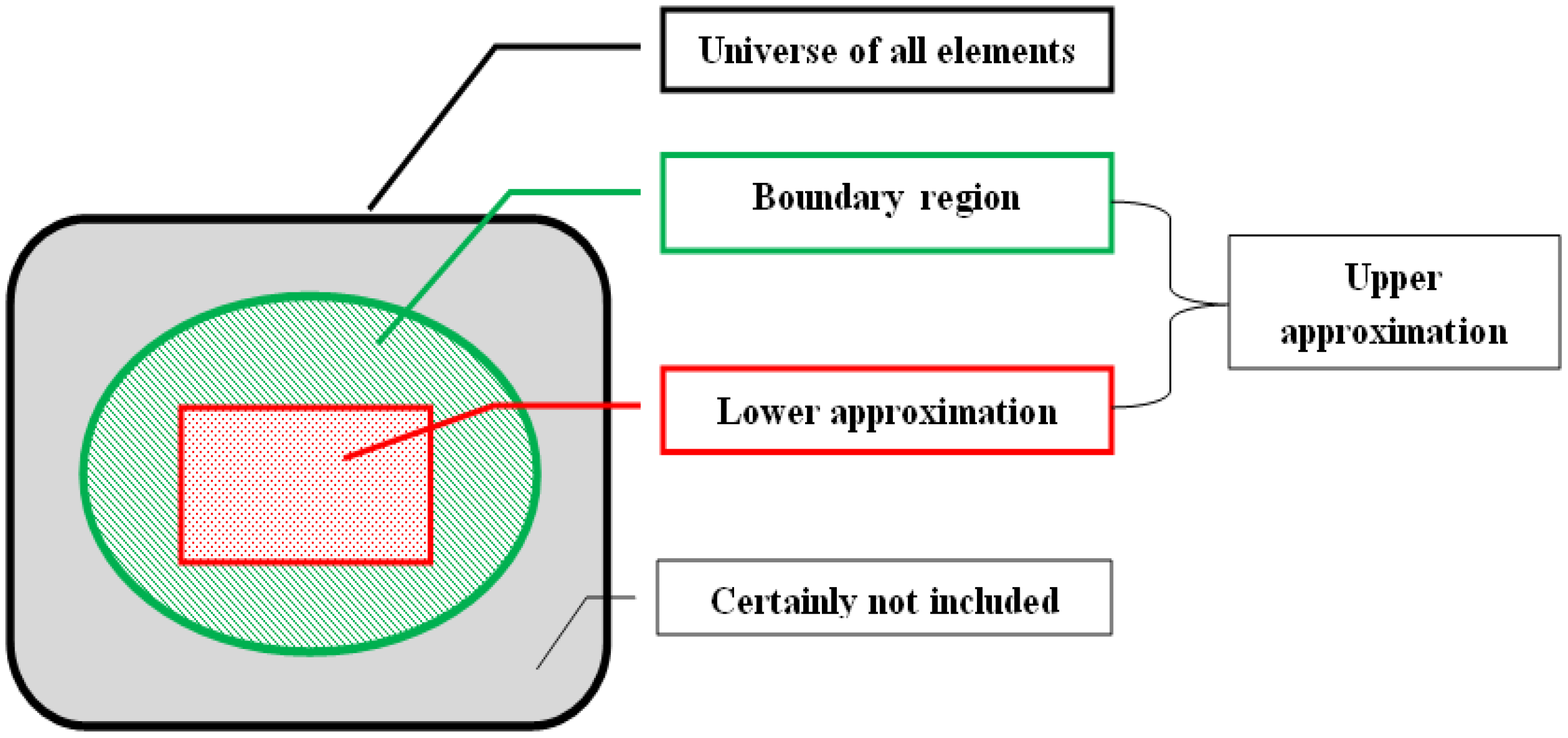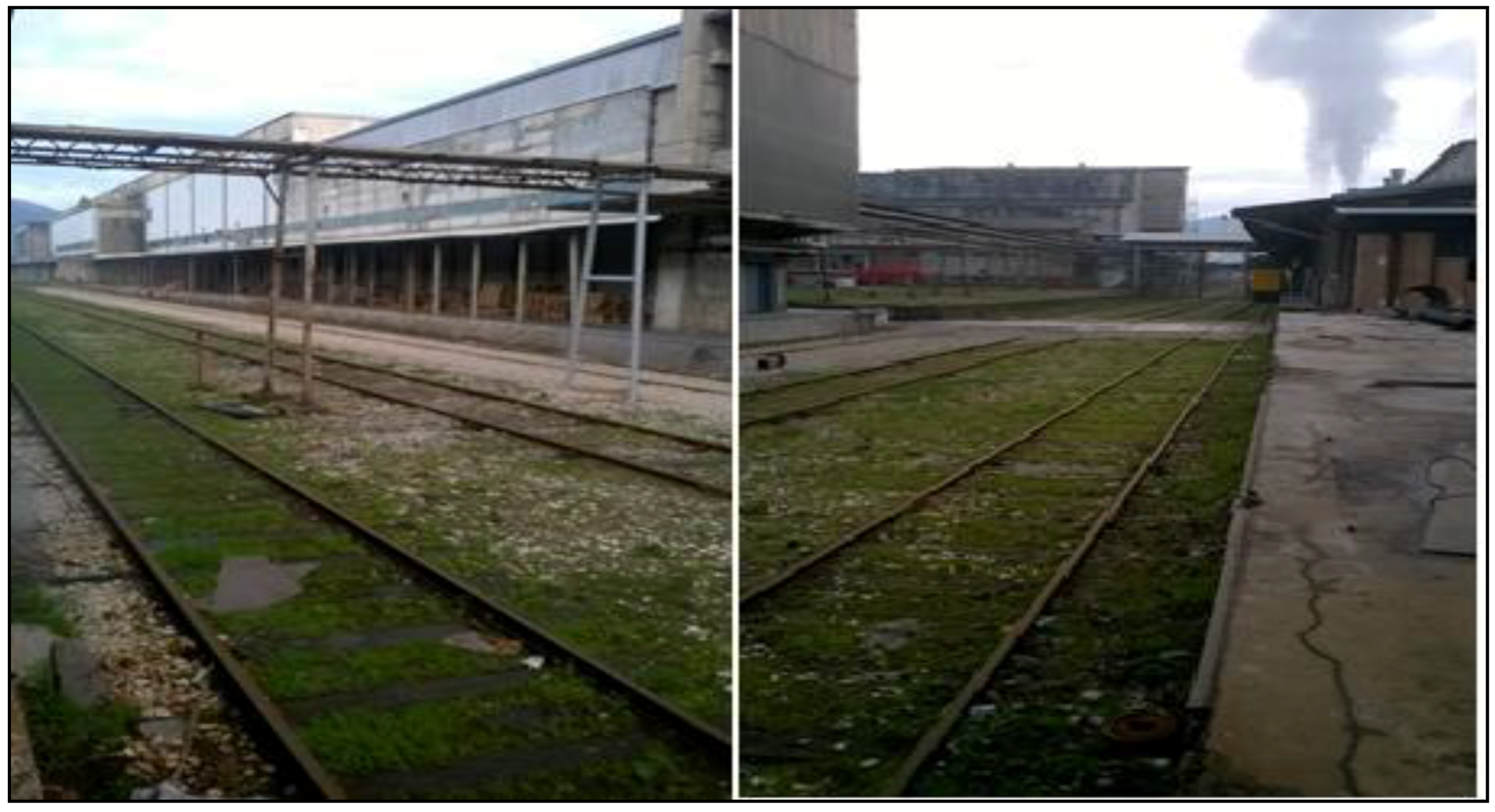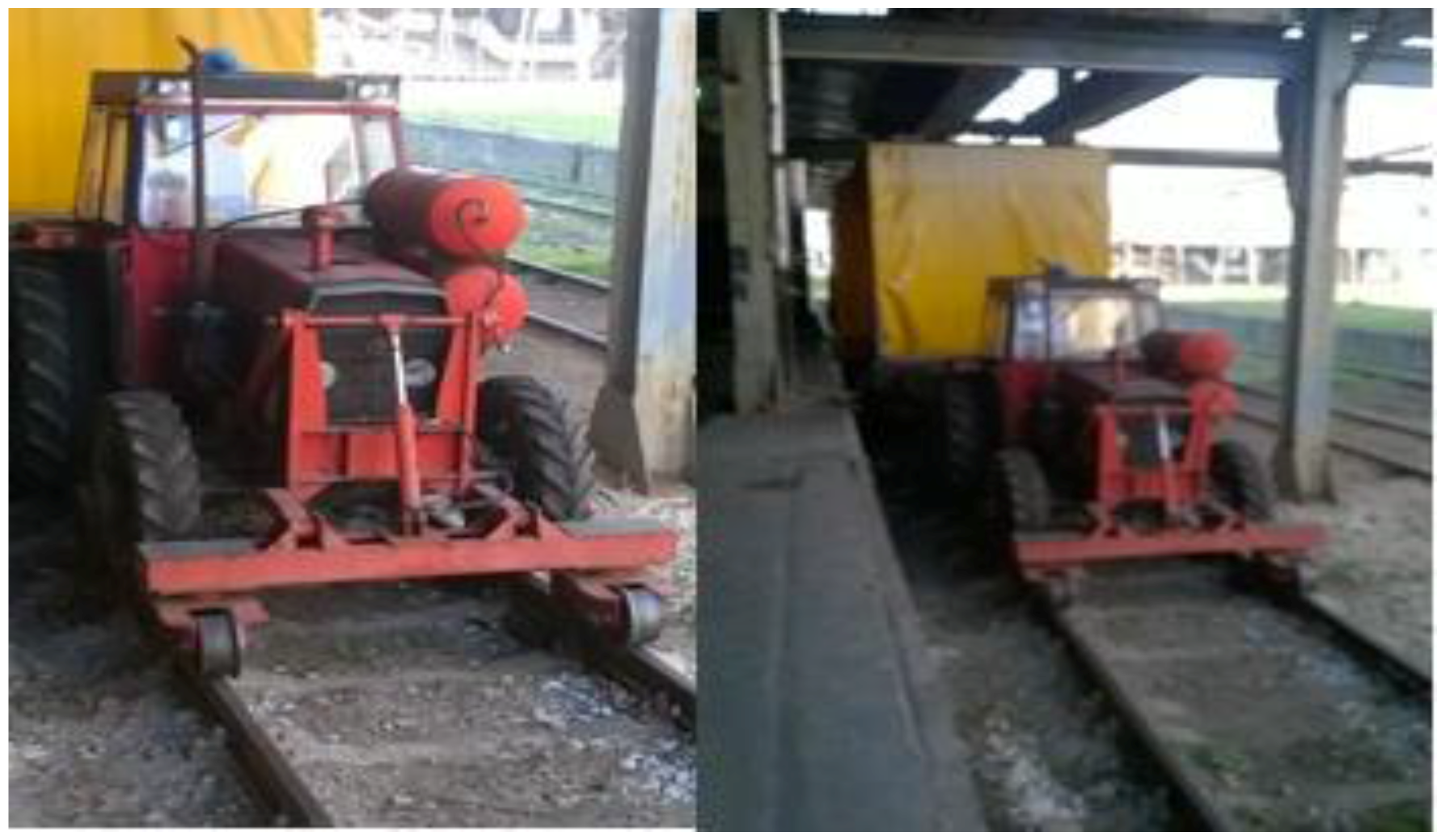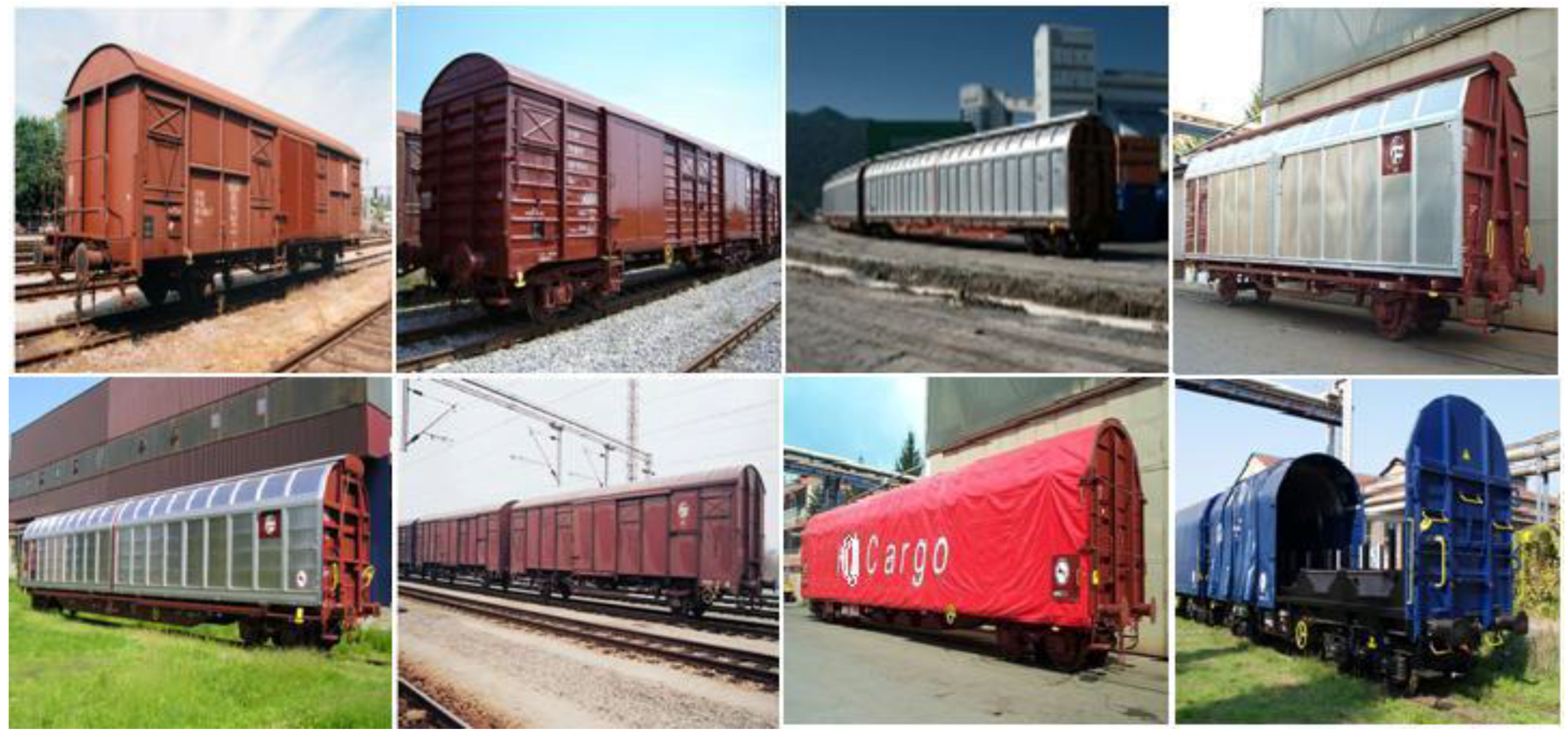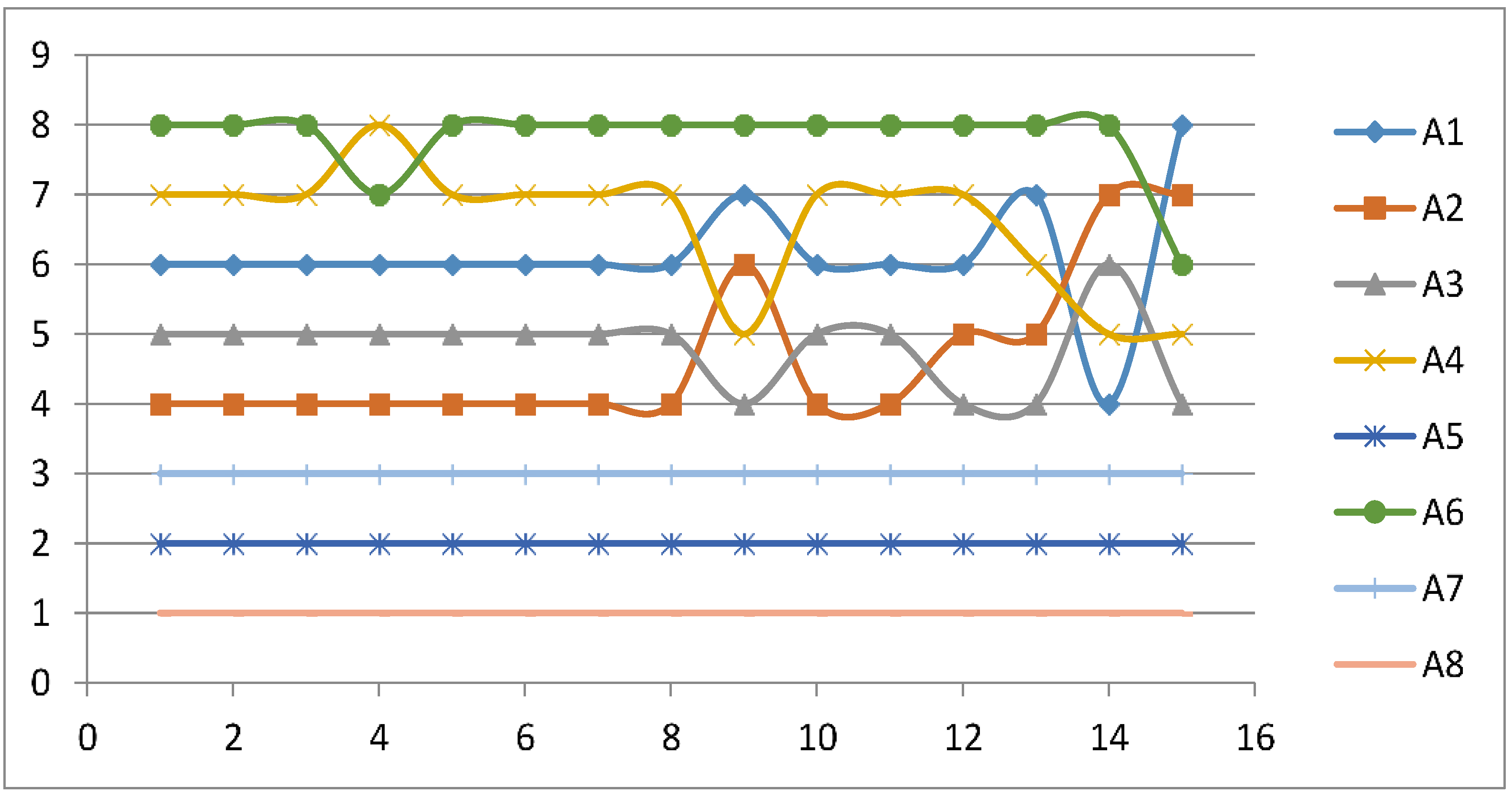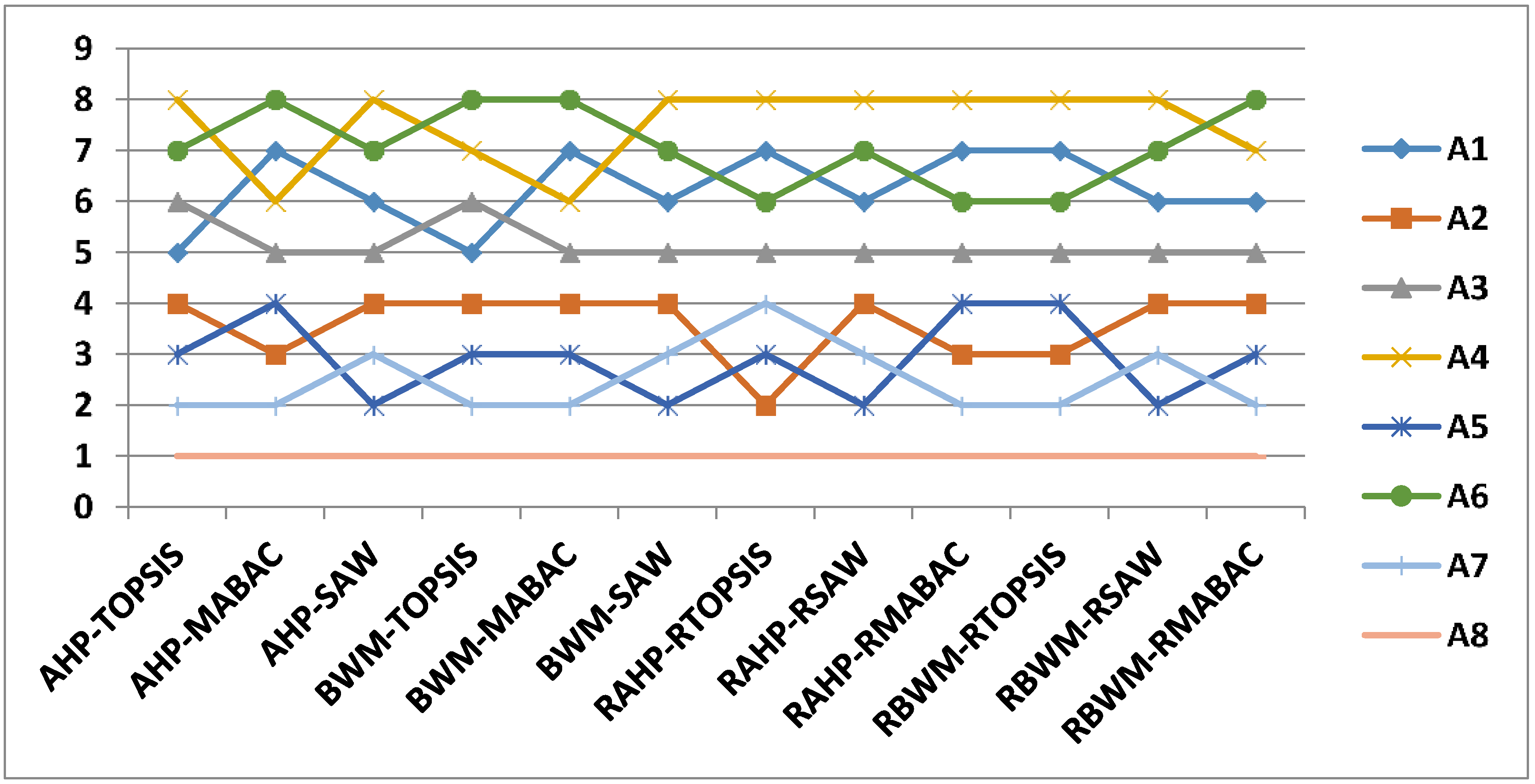3.2. Best–Worst Method
The BWM [
50] is one of the more recent methods. Some of the advantages that cause authors decide to use BWM are as follows: (1) in comparison with the AHP method, which until the establishment of this method was in comparable and most commonly used to determine weight coefficients [
48], it requires a smaller number of pairwise comparisons (in the AHP method, the number of comparisons is n(n − 1)/2, while, for the BWM, the number of comparisons is 2n − 3; (2) weight coefficients determined using the BWM are more reliable, since comparisons in this method are made with a higher degree of consistency compared with the AHP method; (3) with most MCDM models (e.g., AHP), the degree of consistency checks whether the comparison of criteria is consistent or not, while, in BWM, the degree of consistency is used to determine the level of consistency because the outputs from BWM are always consistent; and (4) the BWM for pairwise comparison of the criteria requires only integer values, which is not the case with other MCDM methods (e.g., AHP) which also require fractional numbers.
To more comprehensively take into account the imprecision that appears in the group decision making process, a modification of the Best–Worst (BWM) method was carried out using rough numbers (RN). By using rough numbers, the need for additional information to determine the uncertainty of the intervals of the numbers is eliminated. This maintains the quality of the existing data in group decision making and the perceptions of the experts are expressed objectively in aggregated Best-to-Others (BO) and Others-to-Worst (OW) vectors. Since this is a recent method [
50], there are not many BWM modifications in the literature. In the literature until now, the majority of authors have applied the traditional (crisp) BWM algorithm [
50,
51,
52,
53,
54] and a modification of the BW method carried out with fuzzy numbers [
55,
56]. The approach presented in this chapter introduces RN, which secure a more objective evaluation of the criteria in cases where there is imprecision in the expert decisions. The proposed modification of BWM using RN (RBWM (the Rough Best–Worst Method)) makes it possible to consider doubts that arise during the expert evaluation of the criteria. The RBWM makes it possible to bridge the existing gap that exists in the BWM methodology by applying a new approach in treating imprecision that is based on RN. The next section presents the algorithm for the RBWM that includes the following steps:
Step 1. Determining the set of evaluation criteria. This starts from the assumption that the process of decision making involves m experts. In this step, experts consider the set of evaluation criteria and select the final set of criteria , where n represents the total number of criteria.
Step 2. Determining the most significant (most influential) and worst (least significant) criteria. The experts decide on the best and the worst criteria from the set of criteria . If the experts decide on two or more criteria as the best, or worst, the best and worst criteria are selected arbitrarily.
Step 3. Determining the preferences of the most significant (most influential) criteria (B) from set
over the remaining criteria from the defined set. Under the assumption that there are
m experts and
n criteria under consideration, each expert should determine the degree of influence of the best criterion B on the criteria
j (
). This is how we obtain a comparison between the best criterion and the other criteria. The preference of criterion B compared to the
j-th criterion defined by the
e-th expert is denoted with
(
;
). The value of each pair
takes a value from the predefined scale in interval
. As a result, a Best-to-Others (BO) vector is obtained:
where
represents the influence (preference) of the best criterion
B over criterion
j, whereby
. This is how we obtain BO matrices
,
, …,
for each expert.
Step 4. Determining the preferences of the criteria from set
over the worst criterion (
W) from the defined set. Each expert should determine the degree of influence of criterion
j (
) in relation to criterion
W. The preference of criterion
j in relation to criterion
W defined by the
e-th expert is denoted as
(
;
). The value of each pair
takes a value from the predefined scale in interval. As a result, an Others-to-Worst (OW) vector is obtained:
where
represents the influence (preference) of criterion
j in relation to criterion
W, whereby
. This is how we obtain OW matrices
,
, …,
for each expert.
Step 5. Determining the rough BO matrix for the average answers of the experts. Based on the BO matrices of the experts’ answers
, we form matrices of the aggregated sequences of experts
where
represents sequences by means of which the relative significance of criterion
B is described in relation to criterion
j. Using Equations (1)–(6), each sequence
is transformed into rough sequence
, where
represents the lower limit and
represents upper limit of the rough sequence
.
Thus, for sequence
, we obtain a BO matrix
,
, …,
. By applying Equation (16), we obtain the average rough sequence of the BO matrix:
where
and
,
e represents the
e-th expert (
),
represents the rough sequences. We thus obtain the averaged rough BO matrix of average responses
,
Step 6. Determining the rough OW matrix of average expert responses. Based on the WO matrices of the expert responses
, as with the rough BO matrices, for each element
, we form matrices of the aggregated sequences of the experts
where
represents the sequence with which the relative significance of criterion j is described in relation to criterion W.
As in Step 5, using Equations (1)–(6), the sequences
are transformed into rough sequences
. Thus, for each rough sequence of expert
e (
), a rough BO matrix is formed. Equation (19) is used to average the rough sequences of the OW matrix of the experts to obtain an averaged rough OW matrix.
where
e represents the
e-th expert (
),
represents the rough sequences. Thus, we obtain the averaged rough OW matrix of average responses
Step 7. Calculation of the optimal rough values of the weight coefficients of the criteria
from set
. The goal is to determine the optimal value of the evaluation criteria, which should satisfy the condition that the difference in the maximum absolute values (21)
for each value of
j is minimized. To meet these conditions, the solution that satisfies the maximum differences according to the absolute value
and
should be minimized for all values of
j. For all values of the interval rough weight coefficients of the criteria
the condition is met that
for each evaluation criterion
. The weight coefficient
belongs to interval
, that is,
for each value
. On this basis, we can conclude that in the case of the rough values of the weight coefficients of the criteria, the condition is met that
and
. In this way, the condition is met that the weight coefficients are found at interval
and that
.
The previously defined limits will be presented in the following min-max model:
where
is the rough weight coefficient of a criterion.
Model (22) is equivalent to the following model:
where
represents the optimum values of the weight coefficients,
and
represents the weight coefficients of the best and worst criterion respectively, while
and
, respectively, represent the values from the average rough OW and rough BO matrices (see Equations (17) and (20)).
By solving model (23) we obtain the optimal values of the weight coefficients for the evaluation criteria and .
The consistency ratio is a very important indicator by means of which we check the consistency of the pairwise comparison of the criteria in the rough BO and rough OW matrices.
Definition 1. Comparison of the criteria is consistent when condition is fulfilled for all criteria j, where , and respectively represent the preference of the best criterion over criterion j, the preference of criterion j over the worst criterion, and the preference of the best criterion over the worst criterion.
However, when comparing the criteria it can happen that some pairs of criteria j are not completely consistent. Therefore, the next section defines the consistency ratio (CR), which gives us information on the consistency of the comparison between the rough BO and rough OW matrices. To show how the CR is determined, we start from a calculation of the minimum consistency when comparing the criteria, which is explained in the following section.
As previously indicated, pairwise comparison of the criteria is carried out based on a predefined scale in which the highest value is 9 or any other maximum from a scale defined by the decision maker. The consistency of the comparison decreases when
is less or greater than
; that is, when
. It is clear that the greatest inequality occurs when
and
have the maximum values that are equal
, which continues to affect the value of
. Based on these relationships we can conclude that
As the largest inequality occurs when
and
have their maximum values, then we need to subtract the value of
from
and
and add
. Thus, we obtain Equation (25):
Since for the minimum consistency
applies, we present Equation (25) as
Since we are using rough numbers, and if there is no consensus between the DM on their preferences of the best criterion over the worst criterion, then
will not have a crisp value but we will use
. Since for RN the condition
applies, we can conclude that the preference of the best criterion over the worst cannot be greater than
. In this case, when we use upper limit
for determining the value of CI, then all values connected with
can use the CI obtained for calculating the value of CR. We can conclude this from the fact that the consistency index, which corresponds to
, has the highest value in interval
. Based on this conclusion, we can transform Equation (26) in the following way
By solving Equation (27) for the different values of , we can determine the maximum possible values of , which is the CI for the R-BW method. Since we obtain the values of , i.e., , based on the aggregated decisions of the DM, and these change the RN interval, it is not possible to predefine the values of . The values of depend on uncertainties in the decisions, since uncertainties change the RN interval. As explained in the algorithm for the R-BW method, interval changes depending on uncertainties in evaluating the criteria.
If the DM agree on their preference for the best criterion over the worst then
represents the crisp value of
from the defined scale and then the maximum values of
apply for different values of
,
Table 1.
In
Table 1, the values
are taken from the scale
which is defined in [
50]. Based on
CI (
Table 1), we obtain the consistency ratio (
CR)
The CR takes values from interval , where values closer to zero show high consistency, while the values of CR closer to one show low consistency.
3.3. Rough SAW Method
As already mentioned in the previous section, the SAW method is a simple and easily applicable method of multi-criteria decision making. However, using only crisp numbers, it is impossible to obtain results that treat uncertainty and objectivity in an adequate way. Therefore, this paper continues by presenting a new approach that combines the SAW method and rough numbers. The Rough SAW method consists of the following steps:
Step 1: Define the problem that needs to be solved, which is made up of m alternatives and n criteria.
Step 2: Form a group of
k experts, who evaluate the alternatives according to all the criteria using the following linguistic scale shown in
Table 2.
Table 2 shows a new linguistic scale, based on which a group of experts evaluates the alternatives, taking into account the type of criteria (benefit or cost). In this method of solving engineering problems, it is very important that the evaluation of potential solutions is carried out in an adequate way, therefore implying the application of the mentioned scale. When we have criteria such as for example cost or income that can be shown quantitatively, there will be no complications in solving the problem as long as all criteria can be expressed quantitatively. However, this is not the case when evaluation is carried out using a linguistic scale (qualitative criteria) and when, right at the beginning of quantifying the criteria, there is an incorrect evaluation by experts, since the type of criteria has not been taken into account. If this is the case, it cannot be replaced later by normalization, and the application of a new scale is recommended.
Step 3: Convert individual matrices into a group rough matrix. It is necessary to transform each individual matrix of experts
k1,
k2, …,
kn into a rough group matrix using Equations (1)–(6):
Step 4: Normalize the group matrix using Equations (30) and (31):
denotes the values of the alternatives according to criteria from the initial rough group matrix, while
denotes maximum value of criterion if criterion belongs a set of benefit criteria.
denotes the values of the alternatives according to criteria from the initial rough group matrix, while denotes minimal value of criterion if criterion belongs a set of cost criteria.
The values are marked with “+” and “−” to make it easier to recognize those which belong to different types of criteria.
The previously written equations can be more simply expressed as:
Then, a normalized matrix is obtained:
from matrix denotes normalized values obtained using Equations (30) and (31)
Step 5: Weight the normalized matrix:
where
wjL is the lower limit, and
wjU is the upper limit of the weights of the criteria, expressed as rough numbers obtained using rough AHP or rough BWM as is the case in this paper.
Step 6: Sum all of the values of the alternatives obtained (summing by rows):
Step 7: Rank the alternatives in descending order; that is, the highest value is the best alternative. To rank the potential solutions more easily, the rough number can be converted into a crisp number using the average value.
